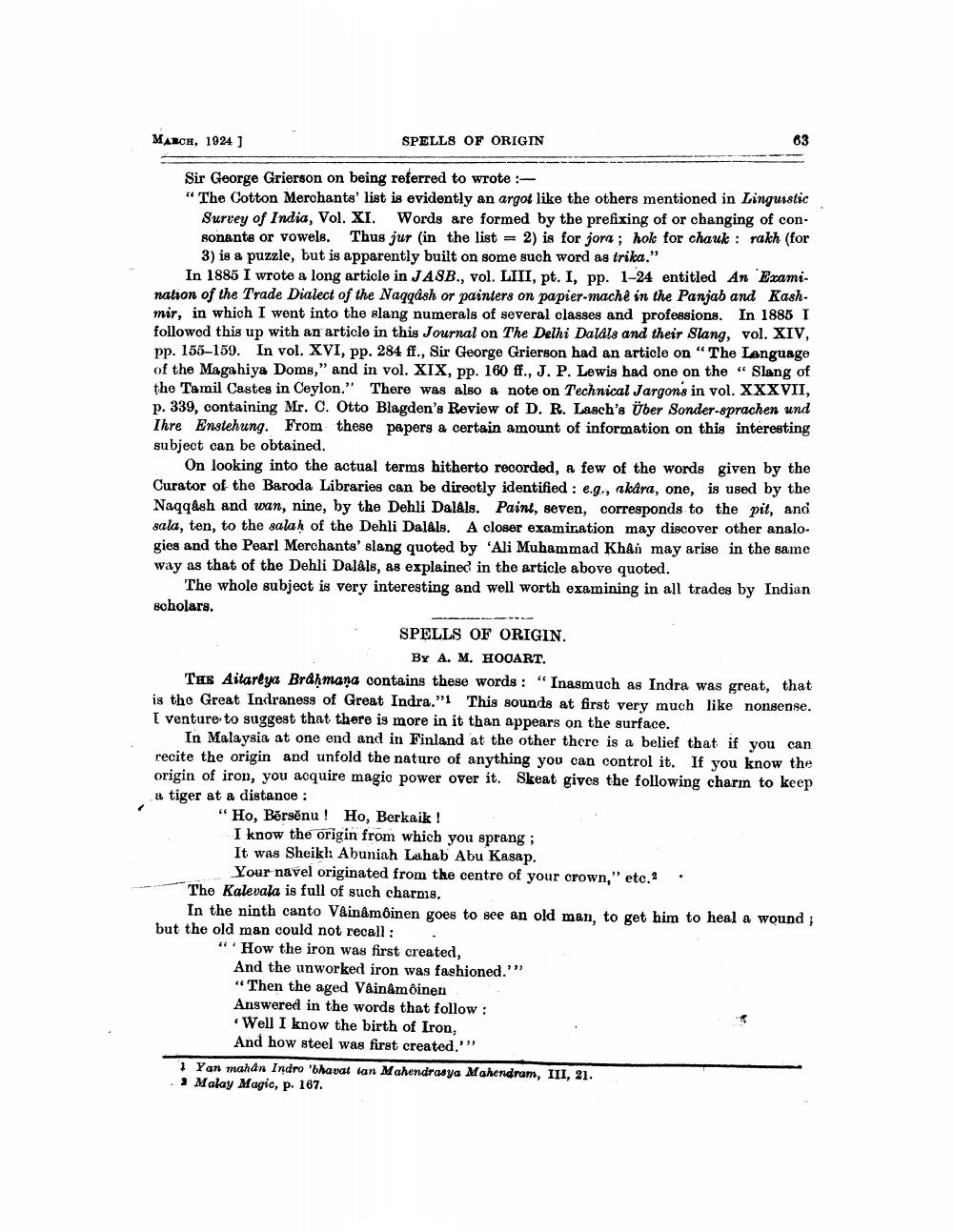________________
MARCH, 1924]
SPELLS OF ORIGIN
Sir George Grierson on being referred to wrote:
"The Cotton Merchants' list is evidently an argot like the others mentioned in Linguistic Survey of India, Vol. XI. Words are formed by the prefixing of or changing of consonants or vowels. Thus jur (in the list 2) is for jora; hok for chauk: rakh (for 3) is a puzzle, but is apparently built on some such word as trika."
In 1885 I wrote a long article in JASB., vol. LIII, pt. I, pp. 1-24 entitled An Examination of the Trade Dialect of the Naqqash or painters on papier-machê in the Panjab and Kashmir, in which I went into the slang numerals of several classes and professions. In 1885 I followed this up with an article in this Journal on The Delhi Daláls and their Slang, vol. XIV, pp. 155-159. In vol. XVI, pp. 284 ff., Sir George Grierson had an article on "The Language of the Magahiya Doms," and in vol. XIX, pp. 160 ff., J. P. Lewis had one on the “ Slang of the Tamil Castes in Ceylon." There was also a note on Technical Jargon's in vol. XXXVII, p. 339, containing Mr. C. Otto Blagden's Review of D. R. Lasch's Über Sonder-sprachen und Ihre Enstehung. From these papers a certain amount of information on this interesting subject can be obtained.
=
On looking into the actual terms hitherto recorded, a few of the words given by the Curator of the Baroda Libraries can be directly identified: e.g., akára, one, is used by the Naqqash and wan, nine, by the Dehli Dalâls. Paint, seven, corresponds to the pit, and sala, ten, to the salaḥ of the Dehli Dalâls. A closer examination may discover other analo. gies and the Pearl Merchants' slang quoted by 'Ali Muhammad Khan may arise in the same way as that of the Dehli Dalâls, as explained in the article above quoted.
The whole subject is very interesting and well worth examining in all trades by Indian scholars.
SPELLS OF ORIGIN.
By A. M. HOOART.
THE Aitareya Brahmana contains these words: "Inasmuch as Indra was great, that is the Great Indraness of Great Indra." This sounds at first very much like nonsense. I venture to suggest that there is more in it than appears on the surface.
In Malaysia at one end and in Finland at the other there is a belief that if you can recite the origin and unfold the nature of anything you can control it. If you know the origin of iron, you acquire magic power over it. Skeat gives the following charm to keep a tiger at a distance:
"Ho, Bērsĕnu! Ho, Berkaik !
I know the origin from which you sprang;
It was Sheikh Abuniah Lahab Abu Kasap.
Your navel originated from the centre of your crown," etc.3
The Kalevala is full of such charms.
63
In the ninth canto Vâinâmôinen goes to see an old man, to get him to heal a wound; but the old man could not recall:
"How the iron was first created,
And the unworked iron was fashioned.""
"Then the aged Väinämöinen Answered in the words that follow:
Well I know the birth of Iron,
And how steel was first created.""
1 Yan mahân Indro 'bhavat tan Mahendrasya Mahendram, III, 21. Malay Magic, p. 167.




